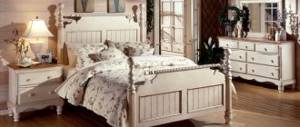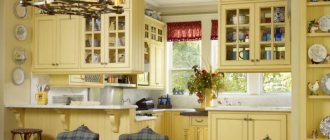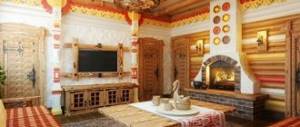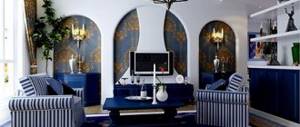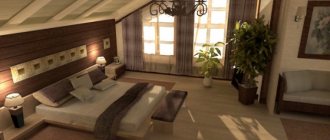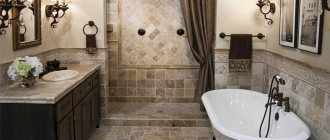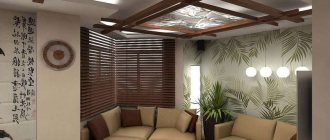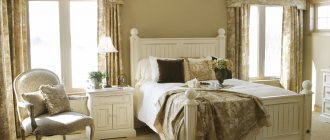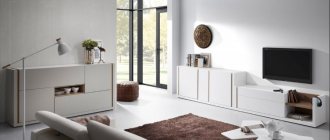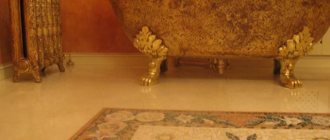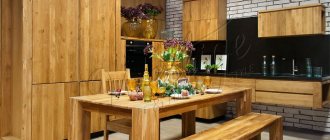The charm of a summer cottage, decorated in a rustic style, lies in its simplicity and naturalness. Residents of large cities treat this type of landscape design with special interest: the surrounding environment helps to more fully feel a harmonious connection with nature, enjoy peace, quiet and detachment from the rhythmic life of the metropolis.
The rustic theme provides unlimited scope for the implementation of the ideas of designers and owners of country houses, and this contributes to the popularity of the country style. When designing a territory in a unified manner, the following objects will require close attention:
- herbal compositions;
- decorative elements;
- paths;
- Walling.
It is important to remember that for each country-style landscape object it is customary to use natural materials - wood and stone.
You may also be interested in the following:
Decorative ponds Construction of paths Landscape design
For questions, please contact us by e-mail: [email protected]
The concept of rustic style in the design of the site
The rustic style in landscape design has not lost its popularity for many decades. This is due to the following reasons:
- its installation does not require large labor and material costs;
- the style is quite democratic and leaves the owner a huge scope for creativity and self-expression;
- allows you to fully realize the site owner’s ideas about a cozy and comfortable corner for living and relaxing.
The main concept of the rustic style is simplicity and naturalness of design while preserving the natural landscape as much as possible. Well-placed accents help make the style recognizable.
This style does not dictate strict requirements for the geometry of the site and allows the use of any available materials, if they are skillfully integrated into the overall concept.
As a rule, professionals try not to give advice or set any boundaries for the owner. The main thing to warn about is moderation.
The main mistake that turns a rustic-style area into a place where random things pile up is the lack of a unified composition and an overabundance of decorative elements. Thus, it is worth remembering the principle “less is more” more often. And if the owner has ten cart wheels, this does not mean that all of them must be used when decorating a lawn or flower bed.
Features of a garden in a rustic style ↑
Let's start by describing the main features of a summer cottage, which is decorated in a rustic style. Based on its name alone, one can assume that it does not have any special strict framework or restrictions. Rather, the distinguishing features here are slight negligence and freedom. Therefore, they design the landscape in this direction, without adhering to clear geometric shapes, and also boldly adding bright colors to it. Thus, it seems to be opposed to the sleek and prim palace gardens.
The feeling of deliberate negligence and naturalness is what is present in a country-style dacha
Note that in each country this style has its own specifics. Therefore, the most interesting for us will be those variations that are close to the Russian people. It will be easier and easier to care for them, as well as get a lot of pleasure and positive emotions from such a kindergarten. We can safely say that on a summer cottage with rustic motifs it is possible to truly relax, since there are no boundaries felt here. The only thing that shines through in everything around you is the riot of colors of nature and its unique natural beauty.
Site planning
Rustic style does not involve strict planning. But this does not mean that everything should be located chaotically. Zoning the site is a very important stage. The best place to start is from home.
In the article about site planning, we talked about how to correctly assess and use the relief features of a site, independently carry out a soil analysis, and determine lighting parameters. All this must be done at the planning stage of a rustic garden. Such an analysis will make it possible to correctly distribute zones across the site, making maximum use of its advantages and neutralizing its disadvantages.
The garden must have a recreation area and a vegetable garden. It is very easy to fit any outbuildings into the overall concept. Paths are not planned in advance. They simply randomly connect selected zones.
Setting up a gazebo and choosing furniture for the dacha ↑
Let's move on to the important point of working on the dacha plot - creating a recreation area. Of course, a gazebo and rustic-style furniture will come in handy here. Let's roughly outline the objects and buildings that can be placed in the corner where you will take a break from your everyday worries and dacha worries. It is best to build a gazebo made of wood, and it can be additionally planted with weaving vegetation. When it envelops the entire structure, it will feel as if nature itself created it.
A gazebo or country house will look as natural as possible if it is surrounded by trees such as birches or weeping willows
We create an appropriate environment inside. Furniture items should be simple and also made of wood. Armchairs or chairs made from wicker will look organic and beautiful. And of course, let them be in their natural color. The effect of your garden will be complemented by the use of gates and fences made of wicker or deliberately carelessly knocked together boards, which are installed even in places where it is quite possible to do without them. In the classic version, they are also decorated with pots or entwined with vegetation. And then any guest on your site will feel like in a real village.
Unity of style
Rustic style is often called "country". However, the rustic style should not be confused with the ethnic one, which implies strict adherence to the national flavor.
To create a recognizable look and style, it is quite acceptable to stick to a certain theme, which will greatly simplify the task. This could be an imitation of a Ukrainian farmstead, a house in the Russian outback, or a farm in France. After all, for example, when mentioning a Ukrainian farm, the imagination immediately pictures pots on the fence, an abundance of sunflowers, a whitewashed hut, a table under a pear tree in the yard.
In a word, to create a landscape design in a rustic style, it is enough to think through the style and acquire suitable materials at hand, as well as drawings and old photographs.
It is worth remembering that the house, if it has already been built, must be brought into line with the chosen style. Modern building materials will allow you to do this quickly and efficiently. It is also worth thinking, for example, about the installation of shutters and carved platbands.
Country style cottage: decor and small architectural forms
It is impossible to imagine a complete picture of a country garden and cottage in a rustic style without the presence of thematic decorative elements and corresponding small architectural forms. Among their dizzying variety we can highlight such original objects as:
- - roughly knocked together furniture - benches, tables, chairs located in the recreation area;
- - simple wooden gazebos and arches;
- - homemade wooden trellises and devices for vertical gardening of a summer cottage (pergolas, fences);
- - clay pots of all sizes (they are used both to decorate the fence and to grow plants outdoors);
- — decorative wickerwork;
- - wooden barrels and tubs;
- - homemade bird feeders and drinkers.
In the design of a country garden, it is allowed to use decorative ceramic figurines depicting all kinds of farm animals - geese, chickens, ducks, cows. But figures of mythical characters like gnomes and cupids, alas, do not fit into the design of a country-style dacha at all.
If there is a large stump in your garden area, then it is not necessary to uproot it, because the surface of such a composite element can be used as a small garden table or as a reliable support for a tabletop. (Of course, the stump should not be rotten or rotten - otherwise, it will simply ruin the whole picture.)
A traditional rural well with a wooden frame will look very impressive in the space of a country garden. If the site already has a more modern source of water supply, such as an artesian well, then nothing prevents you from designing its part protruding above the ground in the form of a well frame with a gable roof.
In addition, many landscape designers also recommend paying attention to the possibility of arranging an artificial pond, which can be placed near the recreation area. The pond should look as natural as possible and resemble a real creation of nature. To make it more convincing, it can be decorated with stones of various sizes and enlivened with real water lilies and other aquatic vegetation.
Fencing
A fence in a village house has always performed many functions: it reliably protected the family from prying eyes, and served as a place where something could be hung to dry. The condition of the fence spoke about the owner’s wealth. Therefore, the fence should be taken seriously.
The fence should be wooden, but its shape can be different:
- wattle fence;
- fence;
- stylized fence from any available materials.
If a gate device is planned, they also need to be integrated into the overall picture, giving the appropriate appearance.
Well
One of the most important techniques in the design of a rustic style is the installation of a well. This is the most labor-intensive and expensive detail of the overall style. Of course, you can stylize a well as a decorative element, but it is best to arrange a real well, which, among other things, will become a source of water for domestic needs and irrigation.
To design the frame of a well, it is worth familiarizing yourself with what wells looked like in villages. Their appearance depended on the design of the lifting mechanism. In Slavic villages, two types of wells were most often used:
- Russian (with a lifting mechanism in the form of a drum on which a rope or chain is wound);
- crane with a lifting lever mechanism.
The upper part of the shaft (head) must be decorated in the style of the general design. The area around the well can be cemented, or it can be planted with flowering shrubs or ivy.
Garden furniture and small forms
The main rule for the location and type of garden furniture is minimum cost and ease of use.
Benches that have served their time, wooden tables, just wooden blocks and old stools - everything can come in handy. Handmade furniture is ideal.
Professionals do not advise getting carried away with garden sculptures when decorating in a rustic style. It is better to give preference to rustic household items - old (or stylized) carts, kitchen utensils, antique bicycles, garden wheelbarrows, garden stuffed animals, wicker baskets.
Pet figurines and sculptures are perfect for the overall concept. Boulders or old stumps covered with flowers will look good.
Landscaping of the site
Lawns, if they are sown, should not have geometric shapes and look well-groomed. Flowerbeds can be arranged completely arbitrarily. A certain negligence and lack of care is quite acceptable - village housewives most often did not have time for ideal flower beds.
Very important elements of this style in landscape design are the garden and vegetable garden. A garden planted with fruit trees will not only create an atmosphere that suits the style, but will also produce a harvest.
In addition to traditional “food” vegetable crops, you can grow colorful giant pumpkins, sunflowers, and ornamental cabbage used in design.
Using all these simple techniques, you can turn your garden plot into a corner of comfort and harmony with nature, without any special financial costs. Caring for a site in this style is not at all difficult, and an already created landscape design can be easily updated and redone with your own hands using available tools.
Many people think about creating a rustic coziness in their dacha or the area in front of their house. But only a few can figure out how to do this correctly without huge investments and with their own hands.
Don't worry, everything is natural and simple in country style. The main thing is to know a few important secrets.
Country style
The “country” style, like no other, embodies the idea of a cozy rural house somewhere in the Russian outback or on the vast expanses of the wild prairies.
The rustic style, born at the beginning of the last century in America, quickly spread throughout the world. For many, this unpretentious interior has become a symbol of home comfort, a quiet life away from the bustling modern cities, and a slight longing for a carefree childhood. The English word “country” can be translated both as “country” and “village”. This determines the features of the style: it organically interweaves rural interiors and the national flavor of different nations. The dominant motifs are traditional and original, belonging to a particular ethnic group. Depending on the country whose culture is reproduced in the interior, both the main details and secondary elements change.
Country style interior - history
The emergence of the style owes much to the wild nature and harsh weather conditions that determined the minimalism and functionality of this trend. Country music quickly gained popularity in the Old and New Worlds, transforming from an American style into a truly international one. In the mid-19th - early 20th centuries, country music became a separate trend in interior fashion, and today its elements in one form or another are present in the culture of every country. Today, a country-style interior is a collective image of a country house with its unique flavor and unpretentious interior.
In each country, national motifs are introduced into the overall image, but the general features of the style are the same for all interiors. The main features of country style are functionality and comfort, light romance and coziness. Traditional colors are light pastel or rich, but muted. Simple ornaments, an abundance of natural materials and natural textiles, soft diffused light - these are the main features of this slightly naive style. Nowadays, it is losing its former simplicity and becoming more stylized, modern and elegant.
Country style interior - modernity
To create a cozy atmosphere in country, they use a simple room layout, giving the interior elegance due to the absence of strict straight lines. Furniture, textiles, accessories are more likely to provide convenience than to add beauty to the interior. An important condition for following the country style is the use of natural materials: wood, decorative stone and tiles, natural fabrics. Interior decoration, including wall decoration, maintains the given tone: simple paper wallpaper with a modest pattern, or wallpaper imitating stonework; whitewash or decorative structural plaster; finishing with wood panels in light colors. In furniture upholstery and textiles - curtains, rugs, bedspreads - stripes, large checks, and a mille fleur pattern are appropriate.
Hand-forged elements fit organically into the interior: curtain rods, furniture handles, window fittings. Matte metal, imitating patina-touched brass or bronze, will emphasize the warmth of country style. It is better to exclude high-tech materials - plastic, glass, chromed metal, replacing them with environmentally friendly ceramics, wicker and straw, and compositions of dried flowers.
Curtains and drapes
Textiles add a special soulfulness to the style: curtains, patchwork bedspreads, wicker rugs, embroidered runners and pillows, lampshades. This creates in the interior that simplicity and lyrical mood that fans of rustic style value so much. Bright and colorful natural or combined fabrics are used to decorate the room. Chintz, linen, cotton and woolen fabrics, similar in texture but with different patterns, reign supreme here. The design of the curtains is the simplest, without bulky parts. It is enough to hang wooden cornices with simple straight curtains or slightly gathered curtains, drape them with light folds, place accents with small bows and ties - and the window will change beyond recognition. The simplicity of the cut of the curtains is more than compensated by the riot of colors.
Country style welcomes rich colors that evoke thoughts of walks in nature: any shades of brown, green, sunny red, sky blue, red and yellow. The motifs are light and unambiguous: small flower bouquets, tartan, thin stripes, polka dots, imitation patchwork. The colorful swirl of curtain fabrics can alternate with calm pastel shades that give rest to the eye and emphasize the play of tones and textures. Printed and calm plain fabrics can be decorated with natural materials (leather laces, raffia), multi-colored buttons, curtain clips in the form of dragonflies and butterflies. Curtain patterns can overlap with the rest of the textile design: pillows, napkins and tablecloths, furniture capes.
Perhaps the most difficult thing in country style is not to overload the interior with bright colors and accessories. A cheerful textile round dance must maintain a delicate balance between elegant simplicity and logical completeness of the interior.
Country style landscape: a little history
The country style in the design of summer cottages came to us from Western Europe, and specifically from the famous design expert Gertrude Jekyll from the British Isles. At that time, English gardeners grew fruits, vegetables, fragrant herbs and flower arrangements in their cottage gardens to decorate their homes. Gertrude revealed all this untouched beauty to the world, complementing it with refined aestheticism and utilitarianism.
Europe accepted this innovation with open arms, and after several years a colossal number of plots in rural country style appeared on its territory. Ornamental vegetable gardens and bright, fluffy flowers did not require painstaking care, which largely influenced their growing popularity. Each nation has contributed to this style, and the country that we know today is the merit of the British, the French, the German burghers, and the American cowboys.
Garden decoration
When designing a garden, you should keep in mind that the outwardly rustic style of the landscape should resemble a slightly neglected, but at the same time, very cozy corner. Its feature is simplicity.
For example, grass should not grow in perfectly evenly trimmed lawns, but in separate lawns, as it pleases (within acceptable limits).
In the photo there is a gazebo in the garden
Trees and shrubs should also grow naturally. The fence enclosing the area can be covered with hops, which will give the area a “half-deserted” appearance. However, there should not be any clutter here - every detail is always in its place.
In addition, there should be no exotic flowers or plants in the garden. As a decoration, you can use wildflowers that you are familiar with and have loved since childhood. Shaded areas are usually decorated with ferns and hostas - these plants can also make the garden more cozy.
Advice! In the garden, it is advisable to perform gentle pruning of the crowns to create the effect of natural growth of the fruit tree.
Trees in the garden should be predominantly fruit trees, as they will delight you with gorgeous blooms in the spring and a harvest in the fall. In such a garden you can install a wooden gazebo, for example, stylized as a log house, and next to the gazebo there can be an artificial pond.
Lighting can be installed around such a resting place, which will allow you to spend time not only during the day, but also in the dark.
Advice! If the site is not connected to electricity, renting a diesel generator for the dacha will help temporarily provide power supply.
Country style vegetable garden
Distinctive features of the country style plot:
- A riot of colors in the form of tomato bushes, golden-headed sunflowers, orange pumpkins, flowering fruit trees, beds of strawberries and all kinds of garden greens is an indispensable feature of the site, the design of which is planned in country style.
- Fences woven from vines, supports for climbing flowers, wooden decks and winding droshky, swings and for watering plants will successfully fit into a style based on environmental purity and naturalness. Wood is the main material for making small forms in the garden.
- Old things, parts and paraphernalia that we inherited from relatives: cart wheels, low fences made of stakes and poles, wooden benches, buckets and watering cans.
- It is not recommended to plant flowers, shrubs and trees strictly according to varieties, types and areas. Everything should create the impression of some negligence and nature untouched by human hands. A country landscape may resemble a fragment of a summer meadow, garden or forest clearing, in which it is impossible to violate any laws of geometry or clear lines, for the simple reason that they simply do not exist.
- An open gazebo made of a log frame, fenced with a low palisade, and a garden bridge spanned over a small stream look organic on such a landscaped area.
Creating a romantic corner in a natural and simple (but at the same time carefully thought out) landscape is the main task of country music.
This democratic style perfectly reflects the Russian mentality, without requiring significant labor and monetary costs.
Read on to find out which plants and decorative elements are preferable to choose for a country-style plot, and which shrubs and flowers are best to avoid.
Provence style in the interior of a country house
The rural country style is well expressed by the Provence style in the interior of a country house. The color scheme and subtleties may vary, but the overall appearance is the same. The most popular at the moment is French Provence.
The interior in the Provence style is distinguished by light finishes, natural materials, textiles in a rustic manner and elegant, yet comfortable decor.
Main features and distinctive features
A country house in the Provencal style is the embodiment of not only the rural life of the southern province, but also its culture. It “breathes” him with calmness and peace. While inside, you plunge into the atmosphere of hot sun, warmth, sea, and romanticism.
A country house in Provence style has a special, light atmosphere
Provence style denies modern devices, furniture made of plastic and steel. Wood, pastel colors, green plants in pots are popular here, the decor is comfortable and simple. Village residents are not in a hurry, they do not chase fashion and new products, so when you are in a room decorated in Provence style, the furniture is shabby, artificially aged, natural materials, antiques, and a lot of decorative items.
The interior of the room consists of simple elements, artificially aged materials and antique decorative items
- lack of bright, saturated colors;
- walls, ceiling are several shades lighter than the floor;
- aged furniture elements;
- all textiles are made from natural fabrics;
- main print – floral;
- the windows are large, with many sections;
- no heavy curtains.
In this interior there is no place for bright flashy colors, and preference is given to calm pastel shades
The entire room, furniture, decor in most cases, has a white, light color. The homeland of this style has very hot weather, so they try to create an atmosphere of coolness and lightness in living spaces.
In French style interiors there are a lot of dried and fresh flowers placed in vases, tubs or herbariums
Color features
Provencal style stands out from others with its unobtrusive, pastel colors. At first glance it may seem that everything is the same color, but if you look closely, you can find many different shades. The environment of hot southern countries cannot be saturated for a long time; in the sun it quickly fades. Decor or furniture items can be bright.
Step-by-step design of a summer cottage in country style:
- A rural-style plot of land should be correctly divided into several zones, delimited (fenced off) from each other by a hedge of wild grapes and hops, or a wicker fence.
- The driveway to the house is surrounded by flowering fruit trees, birch or rowan trees.
- The path to the house should not be straight and neatly paved. The rustic style suggests seemingly untrodden paths along which the human foot steps only occasionally. To create such paths, materials such as natural stone, gravel or granite screenings are suitable. These elements are laid at small intervals, between which lawn grass or ground cover plants (for example, thyme or St. John's wort) are sown.
- In front of the house, a blooming lawn with several types of flowers will look harmonious: calendulas, poppies, cornflowers, daisies, daisies, carnations, etc. A perfectly evenly trimmed lawn contradicts the very essence of the rustic country style.
- Low buildings in the economic zone are decorated with wild rose thickets, lilacs or viburnum.
- It is impossible to imagine a rustic style in landscape design without a decorative vegetable garden with original-shaped beds where cabbage, lush greens, lettuce and onions grow. You can separate the vegetable garden from other zones with the help of gooseberry bushes, red and black currants.
- And, of course, a garden with fruit trees and flower beds with undemanding perennials will add special charm to the site: delightful phlox, delicate bells, proud poppies, important peonies, heat-loving dahlias and colorful pansies. But topiary trimming of plants or neat slides of stones in the country are not welcome.
- You can complement a country-style garden with the most popular rustic elements: a homemade straw effigy, figurines of birds and animals, an old wheelbarrow with fresh flowers, or garden sculptures made from sections of a tree trunk.
Demand for “village” buildings in the Provence style
What is Provence? This direction belongs to the southern styles. When mentioned, associations arise associated with lavender fields and olive groves, with the romance of bygone centuries and modern tourism. Having visited these places, you want to bring home a piece of southern France along with your garden plot, its floral aromas and the smell of herbs.
A country house in the Provence style is an example of provincial simplicity combined with elegance
The external simplicity of the French provincial house is emphasized by the low foundation. There is a certain proportionality, but symmetry is not always observed. The modern version of a country house with a fireplace involves extensions and a large attic or attic. Windows can be decorated with carved wooden shutters, which are never closed, but exist only as a decorative element.
Among the mass of proposals from construction companies, potential customers often choose a house in the Provence style. Photos of facades typical of this provincial style can be found on the Internet, which makes choosing a project easier. The adjacent terraces and paved paths create a special atmosphere.
Probably, somewhere deep down in everyone’s soul, a craving for rustic simplicity awakens. At the same time, I want something more sophisticated and refined. This is the typical style of Provençal buildings, organically combining almost incompatible characteristics.
Provence style houses are usually built from natural materials - stone, wood, brick
Country style in landscape design - photo
Each owner of a dacha or suburban area designs the area adjacent to the house in accordance with his own ideas about a comfortable life. Some people like the English neatness of lawns, others are delighted with alpine slides, and others like simple village life with all the accompanying attributes. Today we invite you to see why the rustic style in landscape design is so good, what are its main features and what needs to be done to envelop your site in comfort?
The main characteristics of the rustic style in the design of the site
- Perhaps the first and main feature of the rustic style in the landscape is its simplicity. Everything here looks nice and pleases the eye, but the lawn grass is not measured down to the millimeter, but grows as it pleases, the same flower pots do not stand, but on the contrary, flowerpots of different sizes and design styles are adjacent to each other, beds with vegetables and flower beds with flowers, but organically combined on one territory. But, despite all the apparent chaos at first glance, you will not find chaos on the site. Everything here has been tidied up by the caring hands of the owners, and rounded and natural shapes are preferred to clear and concise shapes in the design of the site.
- So we have brought out the second component of the village landscape - its naturalness and authenticity. It’s as if everything here was created not by human hands, but by nature. You won’t see any rare or exotic flowers here, but even if an unusual variety of rose suddenly grows in the flowerbed, it will probably be adjacent to “simple” pansies, cornflowers and petunias.
- And just like that, the third distinctive feature of this style emerged imperceptibly - negligence. Just don’t confuse it with sloppiness; you won’t find that on a rustic-style plot.
Carelessly arranged decorative elements create the impression that they were just forgotten on the street by the owners entering the house, and the disorder of neighboring flowers in the flowerbed resembles a forest clearing, a flowering field or a meadow, where no one would even think of planting flowers by variety: cornflowers to the left, and yarrows to the right . As nature “planted” them, so they grow.
Rustic style in the landscape
Decorating a garden in a rustic style
How to arrange a plot in a rustic style
The most suitable materials for these purposes are wood and stone. What is most associated with country life? That's right, a log house, surrounded by greenery, a wicker fence and bright flowers breaking through it. By the way, nowadays it is not necessary to build a wooden house in order for the resemblance to the prevailing stereotypes about the rustic style to be accurate. Modern materials will help solve the problem; for example, wood-look siding is perfect for these purposes. By covering your house with wooden siding, you are already one step closer to realizing your dream.
A rustic fence is either a wattle fence or a wooden picket fence. In any case, we again return to natural material - wood.
Beautiful fence in a rustic style photo
Rustic style plot design
A gazebo and pergola will also be made from it, benches and a table will be made. By the way, if we talk about a rustic-style gazebo, the most interesting option would be one built from untreated boards with a thatched roof. More modern options combine wooden construction, roof tiles and decorative wrought iron elements.
Pergola with swing in the garden photo
Garden paths are also not deprived of attention; they are lined with rough paving stones, stones, sawn wood, or simply covered with gravel or sand.
How to design a vegetable garden in a rustic style
Not a single village plot is complete without a vegetable garden and orchard. Vegetables and herbs grow in the garden, and the garden is surrounded by greenery and generously rewards the owners with a harvest of fruits and berries. Even if your plans do not include stocking up on vegetables and fruits for the winter, growing a few bushes of carrots, cabbage, tomatoes, cucumbers, eggplants and zucchini will not burden you, believe me! But how nice it is to make a salad from freshly picked tomatoes and cucumbers, add herbs and herbs from the garden and season with fragrant sunflower oil. So much for the delights of country life!
In a rustic garden, mixed growing of vegetables, flowers and herbs is practiced. Here, between the rows of tomatoes and carrots, you can see the bright “lights” of marigolds and zinnias. And shallots, parsley and dill neatly frame the beds of peppers.
Rustic style vegetable garden photo
In the garden, designed in a rural style, only fruit trees grow, and they are not planted strictly in any order, but somewhat chaotically, combining different species and varieties in one area. At the same time, the owners do not set records for harvesting; for them, working in the garden is, first of all, a pleasure.
Rustic style flower beds are sure to be a riot of colors. Both wildflowers and garden flowers coexist perfectly in the same area; the main thing is to give preference to simple species: tulips, daisies, decorative sunflowers, marigolds, zinnias, cornflowers. The alternation of contrasting buds on one flower bed, where blue intertwines with yellow, and green shades red, looks especially advantageous.
The primacy of accessories
What there cannot be in abundance on the site is decorations. For example, small architectural forms in the form of a cart wheel, wooden sculptures, stuffed birds and animals will help to organically complete the created rustic style. A fairly popular element of decorating a country-style estate is a decorative cart or garden wheelbarrow, which, along with other peasant household items, is most often used as a flower bed. Agree, growing flowers in a cart, watering can, teapot, old bucket, chair, wooden tub or worn-out shoe is much more interesting than in the ground. In addition, this is a rather bright decor of the site.
Land development always begins with a plan. Rational use and artistic design of a personal plot are possible only as a result of its correct and thoughtful planning, taking into account natural, climatic, local, national and everyday features. In this article we will tell you how to decorate a garden plot with your own hands in a village using scrap materials, and we will give video and photo instructions on how to decorate it.
The smaller the area of the site, the more carefully you need to plan it and think through the design details.
Facade of a house in Provence style: arrangement of a courtyard
In the south of France, houses were built from natural stone and garden paths were created. Pretentious flower beds and rock gardens are not typical for this direction. Rather, the courtyard should resemble a slightly abandoned area with lavender and meadow grasses, overgrown islands and bushes.
An important attribute is a veranda, terrace or small balcony. Everything is buried in fragrant flowers. It seems that the garden with a flower bed begins behind the front door. The vines form a shady gallery along the alley that goes deep into the garden. Photos of Provence style in the interior of a wooden house allow you to appreciate its beauty and grace.
It is not necessary to clad the facades of a house under a tiled roof; partially exposed stone or brickwork is appropriate here. Whitewashing or painting of wall fragments is possible. Everything should look neat, a little rustic and rustic. No plastic or high-tech materials – only natural wood:
- pine;
As a rule, a Provence-style courtyard is replete with green spaces.
- nut;
- alder;
- ash;
- oak.
A characteristic feature is a low stone foundation, which does not require mandatory decoration. The cladding is made of wood, including doors, verandas and partial wall cladding. Panoramic windows are a tribute to modern architectural research; they are not a legacy of Provence-style houses (the photos allow you to see this).
Some buildings are distinguished by large windows with almost floor-length sills. Often there are balconies on the 2nd floor - a lot of light is preferred. They are covered with thick curtains only on the south side. Once upon a time, colorful curtains with garters and ruffles were in fashion; today they can be replaced with blinds or an almost transparent tulle curtain.
Decorating the courtyard of a house in Provence style creates the appearance of disorder
Helpful advice! Instead of curtains, it is better to use embroidered curtains or sliding curtains that organically fit into the country style.
The courtyard traditionally houses outbuildings, a summer kitchen or outbuilding, a garage and a covered gallery covered with grapes or climbing plants.
Relief
When placing elements of the estate and choosing plantings, it is necessary to take into account the location of the place relative to the sides of the horizon, prevailing winds, the condition of the soil and ground, as well as its topography. Natural relief does not always and fully satisfy planning requirements; in such cases, it is recommended to carry out vertical planning.
For small elevation differences (up to 5%), no excavation work is carried out, leaving the natural topography, and the house is built with a basement or ground floor, or only the site for building the house is leveled.
In areas with a steep slope (8-12%), the situation can be corrected by terracing the area across the slope, and the steeper the slope, the more terraces are needed. Stairs are installed between the terraces, and the surfaces of the terraces are connected by retaining walls. As a rule, for small slopes with clayey and sandy loam soils the slope is 1:1.5, for sandy soils - 1:2, that is, a slope 1 m high occupies a strip of land 1.5 or 2 m.
Fence
In addition to their direct functional purpose, fences also play a decorative role, so the arrangement of a personal plot can begin with the installation of barriers. It is better to make the outer fence human height or slightly taller, and the inner fences can be installed with a height of 30 cm to 1 m. The fence consists of posts and sheathing; the materials for the fence can be different.
In addition, the fences can be made in the form of a hedge, planting it in two rows, between which a low metal mesh is stretched. After 2 years, the bushes will grow into it and make it invisible.
Various types of hawthorns, thuja, Japanese quince and others are well suited for green fencing. The bush is trimmed in the second year. Hedges are formed by side and top trimming, which is carried out 2 times a year.
We invite you to watch a video about an alternative option for constructing a hedge.
When designing a personal plot, special attention should be paid to paths. Their correct and beautiful layout plays an important role in landscaping and decoration. The general design of the paths can be geometrically strict or free. There is a direct connection between the paths, the relief and the shape of the site.
First, marking is carried out - straight sections of the paths are marked using a cord, the ends tied to pegs, and curved sections - using one peg as the center of the circle, and the other as the leg of the compass. It is easy to draw smooth curves on the ground by changing the length of the cord and the location of the center.
If you want to lay paths with artificial turf, you need to carry out preparatory work. Along the marking lines, the turf is cut to a depth of 15-20 cm and removed so that a small elevation remains along the central axis so that rainwater flows to the edges. This place prepared for covering is called a “trough”.
Paths can be made:
Ground
— along the stretched cord, use a shovel to cut the edges of the path to a depth of 10 cm. This layer of earth is removed, and the cut area is rolled with a hand roller.
For such paths you only need to sow lawn or white clover. This is exactly how many people design the driveway to the garage, paved with paving slabs for the wheels.
Gravel
- a layer of 7 cm of coarse gravel (4-6 cm) is placed at the bottom of the “trough”, after rolling it - another layer of 5 cm of finer gravel (2-3 cm), and then a layer of sand mixed with clay (1:3 ) 1-2 cm thick, which is compacted well, while watering it with water for better shrinkage. Lastly, another layer of 2 cm of fine gravel is laid, which is also watered and compacted.
Perhaps the most aesthetic type of paths, because such tiles can be of any shape and color and fit perfectly into the design. A dry mixture of sifted sand and cement (4:1) is poured onto the “trough”, and then concrete tiles are laid one at a time, which are leveled and compacted using a rubber hammer. Laying paving slabs is not difficult.
Wooden end paving
- effective and very economical, since wooden “rounds” can be cut yourself. To make such paths, tree trunks of various sizes are treated with an antiseptic (bitumen, drying oil), and then sawed into equal sections of 10-15 cm. Such logs are placed on a 10 cm layer of sand. Small ones are placed in the space between the large ends, and the remaining voids are filled sand.
Made from monolithic concrete
- for such paths, formwork is prepared, which is filled with plastic concrete with fine gravel, prepared at the rate of: 1 part cement, 2 parts sand and 3 parts gravel.
And a few more photos of various paths for a summer cottage:
We invite you to watch this video dedicated to the arrangement of paths.
Front garden and green lawn
When doing work such as landscaping a personal plot,
you can quite simply make it beautiful, clean and elegant by sowing the free space with lawn grass. Such lawns provide places for relaxation, picnics and sports games.
You can also sow lawn grass in the front garden in front of the house, where small trees or shrubs planted in groups look good. In this case, the tallest trees or shrubs are planted in the center of the group, and the shorter ones at the edges.
When planting flowering shrubs in the front garden, their color scheme is taken into account - plants with white, yellow, orange flowers are planted closer to the house, and at a greater distance, near the paths - with red, purple, blue and dark or red-leaved bushes.
The physiological and psychological effects of flowers and their smells on the human body have long been known. Decoration of a personal plot - color compositions are compiled according to the following design rules:
- compliance with color ratio
. Red - green, purple - yellow, blue - orange - such combinations create contrasting and emotionally effective relationships. The color combinations are soft and harmonious: red - yellow, red - blue, purple - orange, purple - green, blue - yellow. White color goes with all colors. When creating flower beds, you need to remember that flowers of warm, soft and harmonizing tones are placed in well-lit, sunny places, and contrasting colors are placed in shaded places. - continuous flowering if possible.
To do this, you need to select flowers with different flowering times. So, in April snowdrops, crocuses, daffodils, and tulips bloom; in May - forget-me-not, lily of the valley, violet, iris, lily, peony; throughout the summer - gladiolus, phlox, purple dicentra, poppy, bell, delphinium; in September - aster, goldenrod, dahlias; in October - chrysanthemums. Roses have a long flowering period - from May to September.
Flowerbeds are arranged in the front garden, on recreation areas, rocky hills, slopes, terraces, and near a pond. The background for the flowers is a green lawn, stones, house walls, and tree trunks. When planting flowers in a flowerbed, you need to take into account that flowers of the same type, but of different colors, look very beautiful together. Variegated mixtures of tones are undesirable. A flowerbed does not become beautiful because there are many types of flowers on it. It is not the quantity that is important, but the harmony between colors. Another rule for arranging a flower garden is that the further the flowers are planted from the path, the larger the color spot can be and the higher the flowers themselves.
When choosing flowers, it is necessary to take into account their requirements for soil and light, the growing season, resistance to wind, time and period of flowering, decorativeness, plant height, etc.
Roses occupy a special place in the landscaping of the site. Almost continuous flowering and a wide variety of colors put the rose in first place in the decorative design of the site. Roses are planted in a sunny, bright place, protected from the wind. Climbing roses are planted on the south side of the house. An excellent background for these flowers is a green lawn, coniferous trees, stones of retaining walls and terraces.
